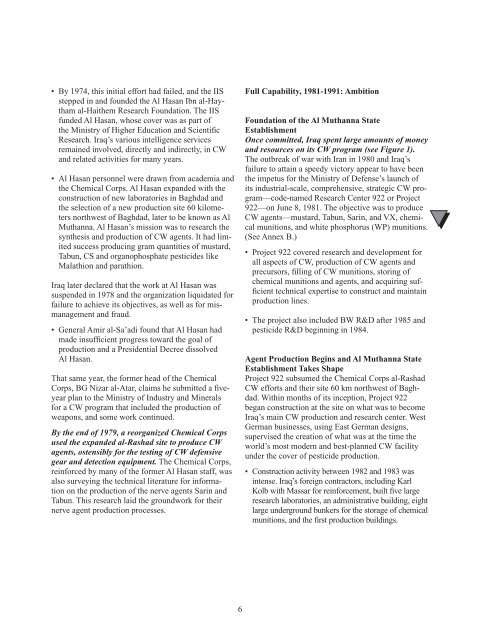Comprehensive Report
GPO-DUELFERREPORT-3
GPO-DUELFERREPORT-3
- No tags were found...
You also want an ePaper? Increase the reach of your titles
YUMPU automatically turns print PDFs into web optimized ePapers that Google loves.
• By 1974, this initial effort had failed, and the IIS<br />
stepped in and founded the Al Hasan Ibn al-Haytham<br />
al-Haithem Research Foundation. The IIS<br />
funded Al Hasan, whose cover was as part of<br />
the Ministry of Higher Education and Scientific<br />
Research. Iraq’s various intelligence services<br />
remained involved, directly and indirectly, in CW<br />
and related activities for many years.<br />
• Al Hasan personnel were drawn from academia and<br />
the Chemical Corps. Al Hasan expanded with the<br />
construction of new laboratories in Baghdad and<br />
the selection of a new production site 60 kilometers<br />
northwest of Baghdad, later to be known as Al<br />
Muthanna. Al Hasan’s mission was to research the<br />
synthesis and production of CW agents. It had limited<br />
success producing gram quantities of mustard,<br />
Tabun, CS and organophosphate pesticides like<br />
Malathion and parathion.<br />
Iraq later declared that the work at Al Hasan was<br />
suspended in 1978 and the organization liquidated for<br />
failure to achieve its objectives, as well as for mismanagement<br />
and fraud.<br />
• General Amir al-Sa’adi found that Al Hasan had<br />
made insufficient progress toward the goal of<br />
production and a Presidential Decree dissolved<br />
Al Hasan.<br />
That same year, the former head of the Chemical<br />
Corps, BG Nizar al-Atar, claims he submitted a fiveyear<br />
plan to the Ministry of Industry and Minerals<br />
for a CW program that included the production of<br />
weapons, and some work continued.<br />
By the end of 1979, a reorganized Chemical Corps<br />
used the expanded al-Rashad site to produce CW<br />
agents, ostensibly for the testing of CW defensive<br />
gear and detection equipment. The Chemical Corps,<br />
reinforced by many of the former Al Hasan staff, was<br />
also surveying the technical literature for information<br />
on the production of the nerve agents Sarin and<br />
Tabun. This research laid the groundwork for their<br />
nerve agent production processes.<br />
Full Capability, 1981-1991: Ambition<br />
Foundation of the Al Muthanna State<br />
Establishment<br />
Once committed, Iraq spent large amounts of money<br />
and resources on its CW program (see Figure 1).<br />
The outbreak of war with Iran in 1980 and Iraq’s<br />
failure to attain a speedy victory appear to have been<br />
the impetus for the Ministry of Defense’s launch of<br />
its industrial-scale, comprehensive, strategic CW program—code-named<br />
Research Center 922 or Project<br />
922—on June 8, 1981. The objective was to produce<br />
CW agents—mustard, Tabun, Sarin, and VX, chemical<br />
munitions, and white phosphorus (WP) munitions.<br />
(See Annex B.)<br />
• Project 922 covered research and development for<br />
all aspects of CW, production of CW agents and<br />
precursors, filling of CW munitions, storing of<br />
chemical munitions and agents, and acquiring sufficient<br />
technical expertise to construct and maintain<br />
production lines.<br />
• The project also included BW R&D after 1985 and<br />
pesticide R&D beginning in 1984.<br />
Agent Production Begins and Al Muthanna State<br />
Establishment Takes Shape<br />
Project 922 subsumed the Chemical Corps al-Rashad<br />
CW efforts and their site 60 km northwest of Baghdad.<br />
Within months of its inception, Project 922<br />
began construction at the site on what was to become<br />
Iraq’s main CW production and research center. West<br />
German businesses, using East German designs,<br />
supervised the creation of what was at the time the<br />
world’s most modern and best-planned CW facility<br />
under the cover of pesticide production.<br />
• Construction activity between 1982 and 1983 was<br />
intense. Iraq’s foreign contractors, including Karl<br />
Kolb with Massar for reinforcement, built five large<br />
research laboratories, an administrative building, eight<br />
large underground bunkers for the storage of chemical<br />
munitions, and the first production buildings.<br />
6


